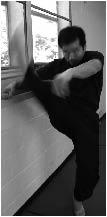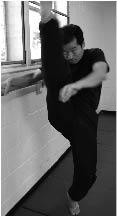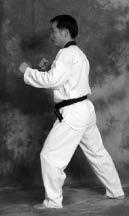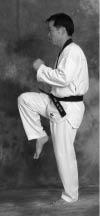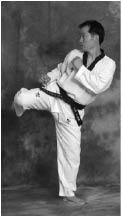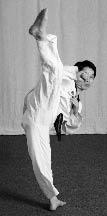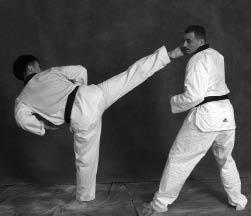Complete Kicking (16 page)
Authors: Turtle Press

2. Swing your rear leg up and down a few times, beginning small and increasing in height progressively.
3. As you feel your kicking leg relax and lighten, raise it once to maximum height, then return to step 2. Repeat 10 times on each side.
height drills
Using a visual, physical target is a good way to increase your kicking height and to keep track of your improvement. If you are having difficulty improving, take a measured progressive approach. For example, set a goal of increasing your target height one-quarter inch every other day. If you can achieve these small increases regularly, you’ll have increased your kicking height by 12 inches in about 3 months!
common mistakes
MISTAKE 1: The most serious mistake with axe kick is overworking your muscles. When you try too hard to raise your leg high, the muscles get tight leading to pain and frustration.
SOLUTION: The easiest solution is to lower your target height and build up progressively. If you have prolonged pain in your muscles, rest and heal first, then begin at a height you feel comfortable with and build up gradually as described on pages 126-127.
MISTAKE 2: Pulling the toes of the kicking foot.
SOLUTION: If you lift your leg with your foot, you’ll find that you have to pull your toes back to create enough lifting force. Instead, lift your leg from your hip and thigh, keeping your foot and ankle relaxed.
• remember
1. Create good posture to leave the kicking leg free of tension.
2. Plant your standing foot firmly for stability.
3. Build the height of your kick progressively.
4. Raise your leg straight upward quickly and drop your foot on the target.
• avoid
1. Pulling the toes, which causes the hamstring muscle to tighten
2. Lifting the heel, decreasing stability
3. Over-stretching, causing a loss of balance and opening yourself to counterattacks
WHIP KICK
purpose
Whip kick is used to strike the opponent across the head or face. In general, use a back leg whip kick for attacking and a front leg whip kick for counterattacking. Setting up the proper distance and height is the key to success in using the whip kick as a counterattack. The best option: just as the opponent finishes his kicking attack, throw a whip kick counter to his face.
key points
Whip kick is a good way to strike your opponent with a surprise counterattack. Wait until your opponent exposes his face after an attack and then strike.
striking area
Bottom of the foot, toes
targets
1. face
2. temple
3. neck
how to
1. From fighting stance, shift your weight to the front leg.
2. Bring your knee up pointing toward the target.
3. Pivot your standing foot and align your body perpendicular to the target, with your shin parallel to the floor and knee tightly folded.
4. Raise your knee as you unfold it and hook your foot across the target, pulling your foot toward your buttocks as you open your hip. Kick through the target and return to fighting stance.
Kick horizontally across the target with maximum range of motion.
The horizontal alignment of the hip shown here enables you to kick higher and wider.
applications
A front leg whip kick is faster and easier to do than a rear leg whip kick. The most effective targets for whip kick are the jaw, cheek, temple, and neck. The key to throwing a successful whip kick is timing; you must react as soon as you see an open target. If you delay even a fraction of a second, your opponent will be too close or too far away to strike. When you practice whip kick, focus on a quick initiation of the kick and a direct path of movement to the target.
SPORT APPLICATIONS
As the opponent steps in, throw a front leg whip kick to the jaw.
Other books
After Hours by Rochelle Alers
Shadow Play by Frances Fyfield
Future Perfect by Suzanne Brockmann
Something Sparked-nook by Mari Carr
Faithful Dead by Clare, Alys
Perfectly Dateless by Billerbeck, Kristin
Worth Taking The Risk by Bennie, Kate
True Love by Wulf, Jacqueline
Under a Georgia Moon: Georgia Moon Romance Book 1 by Cindy Roland Anderson
